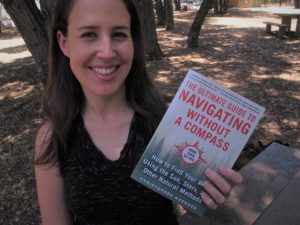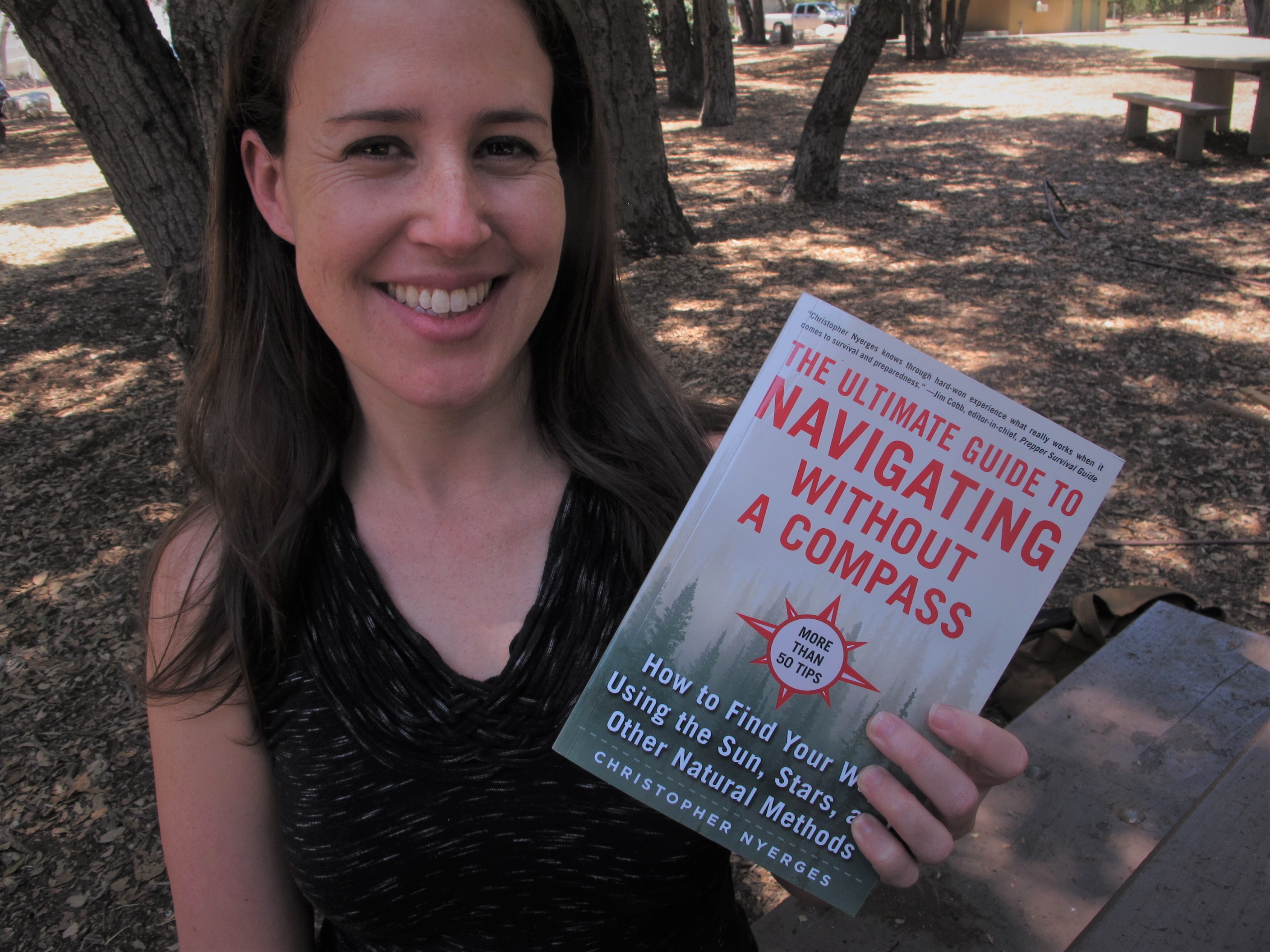Description

“The Ultimate Guide to Navigating Without A Compass: How to Find Your Way Using the Sun, Stars, and Other Natural Methods” by Christopher Nyerges, published in 2020. An excellent addition to your SURVIVAL KIT!
This is a full color guide, 154 pages, which begins with all the natural ways to determine directions, such as the lean of trees, the melting of snow, animals signs, etc. Some of this is often in the category of “folklore,” though there is a grain of truth in most of it.
Then the book addresses all the ways you can determine directions by watching the sun, such as making a simple shadow compass with a stick in the ground, and other observational techniques. This method will also work with a full (or close to full) moon. Ever wonder how to tell directions by the constellations? This book tells you how Though the title does (inconveniently) say “…without a compass,” in fact, the book explains how to read a map and ways to align your map with the natural terrain using any of 3 somewhat simple methods. The book describes the parts of the compass and the simplest ways to use a compass alone, as well as with the map. The details of PAUL method are also described, which is a way to create a map of where you have just travelled, assuming you have a compass and a watch.
The book concludes with many good tips for not getting lost in the first place.

The book includes details for making your own Star Dial for telling time by the position of certain stars in relation to the North Star. You’ll learn that all stars in the northern hemisphere appear to rotate counterclockwise around the North Star, in a cycle that takes 23 hours and 56 minutes!
According to Jim Cobb, editor of Prepper Survival Guide, “Nyerges knows through hard-won experience what really works when it comes to survival and preparedness.”

BACKSTORY: WHY I WROTE MY BOOKS
This book arose from my teaching on how to use a map and compass, which quickly broadened out to wider methods of determining directions.
The book begins with nature observations, most of which are quickly being forgotten because of our reliance on modern gear and devices. These include observing the ways trees grow, feeling rocks for heat or cold, observing how the sides of fences and buildings that face the sun are more faded than those which are in the shade, and many other observations. This section helps to awaken your child within.
Then, the book addresses the observations of the sun, and how placing a stick in the ground and observing the motion of the shadow can tell you nearly everything you need to know about directions, and the motion of our planet.

![]()
![]()
![]()
![]()
In fact, since the moon travels in the same zone as the sun from east to west, you can also use the shadow stick with the moon.
We also address the so-called constellations of stars, and how they rotate. It’s actually the earth that is rotating, and knowing how the stars appear to rotate give can help you determine directions. Certain constellations are identified which are well-worth getting to know. This book provides a disc that you can copy and use for determining time based on the position of certain stars around the north star.
Then, we cover how to read a map, how to use a compass, and how to use the map and compass together. We also share the details of the PAUL method of creating a map of your daily travels with only your compass, so you can chart the shortest path back to your starting point.
One criticism of this book (on-line) was that that the title suggests ways to get around without a compass. “So why are you talking about how to use a compass?” asks one reviewer. The reason is because the publisher, not the author, chose that title, despite the fact that the use of the compass is included. There is no easy way to explain-away that discrepancy, except to understand that when a writer “signs -on” with a publisher, it is kinda sorta-like getting married. You married folks know that you don’t always get what you want, right? OK, so that’s really the best explanation…
FROM THE BOOK
Telling Directions by Nature Observations
Can it be done? Is it always right?
Is it possible to navigate the outdoors accurately without a map and compass? What about all the “rules of thumb” that we’ve heard forever? Do they work?
In fact, there is no single natural observation that will tell you directions. You need to be observant of many features and understand what they mean. You need to use your common sense and you need to be able to “think on your feet.”
Let’s explore some of the questionable rules of thumb we’ve all heard:
“Moss Grows on the North Sides of Trees”
We have long heard that moss grows on the north side of trees. We have all heard this so often that you’d think it was some sort of absolute dogma. I still recall in my high school years when I was taking backpacking and survival classes from Abbey Keith of the Sierra Madre Search and Rescue Team. On one Saturday morning, he asked all of us, “Does moss grow on the north sides of trees?” The room was somewhat silent. Everyone was leaning towards a strong “yes,” but no one answered. “Yes,” said Keith loudly with a broad grin. “It does! But it also grows on the east side, the south side, and the west side of trees, especially in a dense forest where there is little light.” Everyone laughed.
Though there is logicto this idea, and though in a clearing the moss is predominantly on the northern half of the tree (there’s less light there), it is not a precise, nor reliable, method of direction-finding.
Moss (and lichens and algae) doesn’t really care if it’s on the north side of a tree, or a barn, or a rock. It just grows where there is moisture, and the moisture may have nothing to do with with north-south orientation.
Not very good for precision direction-finding, but it might be a useful observation, in conjunction with other observations.
“All Rivers Flow to Civilization”
This is another of those “rules” that we hear a lot: All rivers flow to civilization. It’s been said so often that it has taken on the status of a dogmatic reality in the minds of many. If you’re lost, just follow the river downstream and eventually, hopefully, you’ll end up in some town. Really?
This myth has been repeated over and over that it seems to be a fact in the minds of many. And since it sometimes does work, its efficacy seems enforced. But it simply isn’t always so. Just look at a map. Such “truisms” fall into the category of “old husband’s tales.”
If you are lost, following a stream down-stream might lead you in to a town. Sometimes. After all, settlements need water, and people build near the water. A river is bigger than a stream, so a river seems like a more likely candidate to have a town near it than the stream, which might be more rugged and seasonal. Still, following a river or a stream might also lead you ito very rugged wilderness, so this is not a sure-fire way to get “un-lost.”
“Woodpecker holes are on the east sides of trees”
It has been said that the holes of woodpeckers are always on the east sides of the trees, but this is demonstrably false. It has been observed by bird-people that the pileated woodpeckers tend to peck primarily on the east sides of trees. This is still a bit too imprecise to be of any practical value; plus, how many of us can differentiate between the holes made by the pileated woodpecker and any other woodpecker’s holes? And suppose you actually see the woodpeckers? How many of you know the difference between the pileated woodpecker and any other woodpecker or sapsucker you might encounter? 

I once did an informal poll at an Audubon meeting to see if any of the bird-people knew how to determine the pileated woodpecker from any other woodpecker. Most of them knew the difference, and they chided me for my ignorance of birds. OK, so I’m not a bird person. Still, what if you just see the woodpecker holes on a tree? You can’t tell what woodpecker made the holes, just by the holes, can you?
“The North Star is the Brightest Star in the Sky”
The North Star is NOT the brightest star in the sky. However, it is highly significant for finding directions.
If you follow it with time lapse photography (in the northern hemisphere), the North Star will appear to be stationary, and all the stars would appear to rotate counter-clockwise around it. So if you’ve ever seen a photo where all the stars appear to rotate around a single point, that single point is the North Star! If you were standing on the North Pole, the North Star would be directly overhead (within one degree).![]()
![]()
Knowing how to identify the north star helps with direction-finding, so let’s learn how to identify it. First, begin by locating the Big Dipper. The North Star is in a direct line with the two end stars of the Big Dipper (see illustration).
Go outside on a clear night to your viewing spot and face the north. In this combination of stars, ancient people saw a large water dipper, as if it were scooping water. Locate the outer two stars that comprise the “dipper.” We call that distance x. Those two stars are in a direct line to the north star. If you continue a line with a distance of 5x, in the direction that the dipper would be pouring, you find the north star!
Once you’ve found the North Star, you automatically know the other directions.
Tips of trees
Tips of certain trees will tend to point in specific directions. This is usually a result of prevailing local winds, and because the tree tips are the most tender and susceptible to bending.
Deciduous trees, if isolated, tend to show the heaviest growth towards the south, meaning, towards the sun.
These are good observations, to be used in conjunction with other observation.
Natural Observations work, but you cannot rely on just one observation. There are many, many natural observations not mentioned here, and you need to observe everything, including the sun, the moon, the shadows, snowmelt, dryness vs. wetness, etc.
The best thing to do when entering an area unknown to you is to obtain a map of the area and study it carefully.



